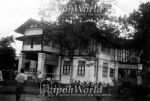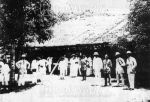We've tried to ensure the information displayed here is as accurate as possible. Should there be any inaccuracies, we would be grateful if you could let us know at info@ipohworld.org . All images and content are copyright.
(Please click on the thumbnail for a bigger image.)
History Of The Elim Gospel Hall, Ipoh (1913 - 2003) - Part 03 - The Beginnings Of Elim Gospel Hall




The first building erected was the big and imposing double storey Mission House (presently the Mission House / residence of the Full-time Worker) made of half-wood, half-concrete. It was built by Mr. Claude Henry LaBrooy (the late Miss Leila Labooy’s father) an architect and contractor. Mr. Claude Henry LaBrooy also gave generously to the Lord’s work. Building work started in 1913 most probably before the Wilsons went on leave and the building was completed in early 1914. A baptism pool made of cement was built outside just beside the house for baptism services. Around this time the first assembly conference was held in Ipoh. As the Mission House was not quite ready for use, the conference was held in a workers’ construction shed in the Labrooy compound in Dulcieville Lane, behind the Main Convent School.
When the Mission House was completed, Sarah Shirtliff and Rose McCann moved from Kampar to live in it. The Wilsons returned to Malaya from England in early 1915 and moved into the Mission House in Ipoh. Subsequently Sarah transferred to Kuala Lumpur to do further missionary work. Rose McCann stayed on and later moved out of the Mission House to Brewster Road.
After the Wilsons took up residence in Ipoh in 1915, assembly work in Elim Gospel Hall began in earnest. Initially assembly or worship meetings were held in the Mission House in the large front room downstairs as there was no hall then. The first congregation probably numbered about twenty, made up of the missionaries, some expatriate civil servants and a few locals. There were so few Christians in those early years. Mr. Wilson began his main thrust of missionary work by working tirelessly for the conversion of souls. He even preached in Hakka, one of the main Chinese dialects in the Kinta Valley, which he had learned in China back in 1899. Work was slow but God’s faithful worker shared the love, the power and majesty of Jesus in all the indoor and outdoor meetings and God prospered his ministry.
From left to right the photos show:
To go to Part 04a, click here.
To read about C H LaBrooy and Dulcieville, click here.